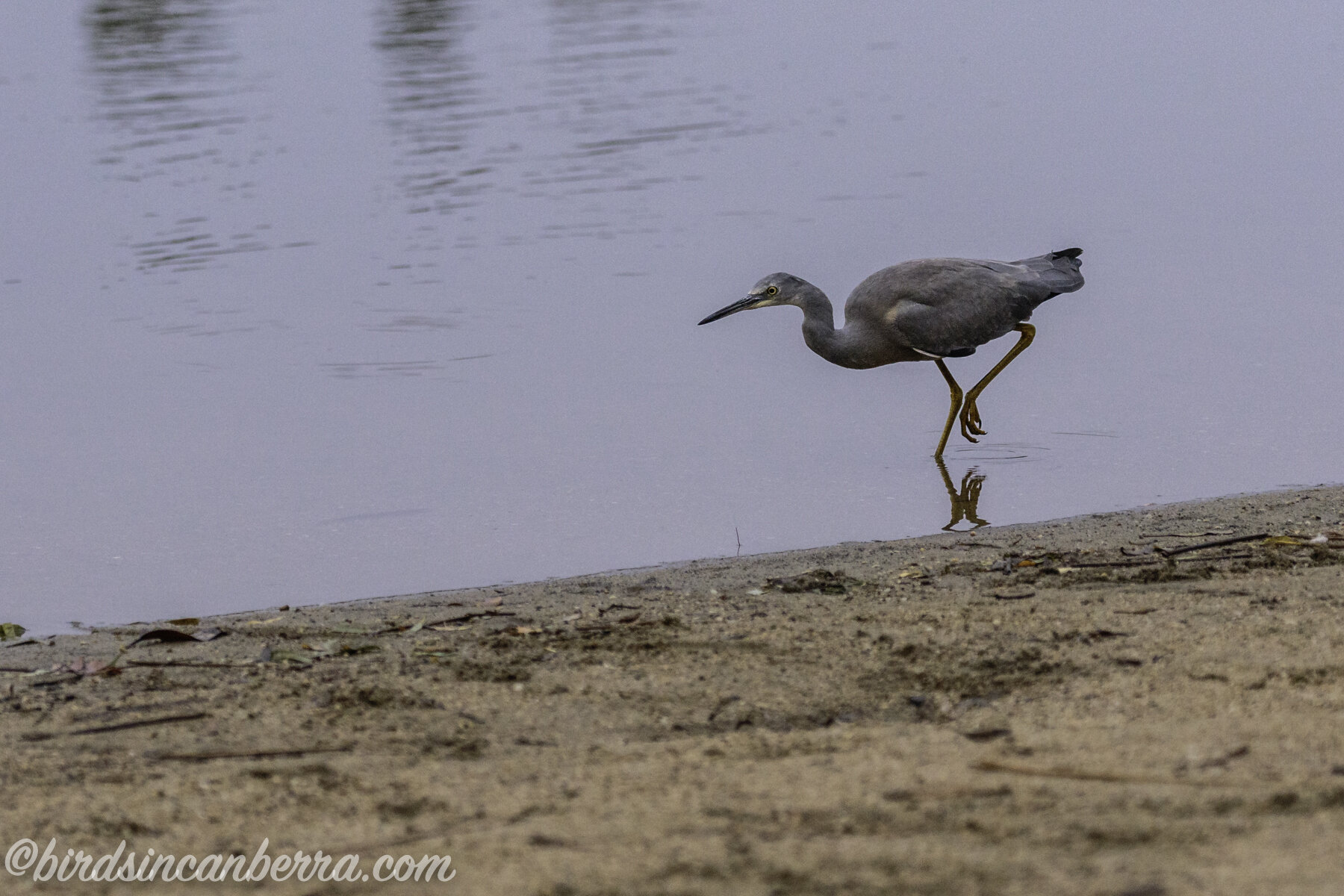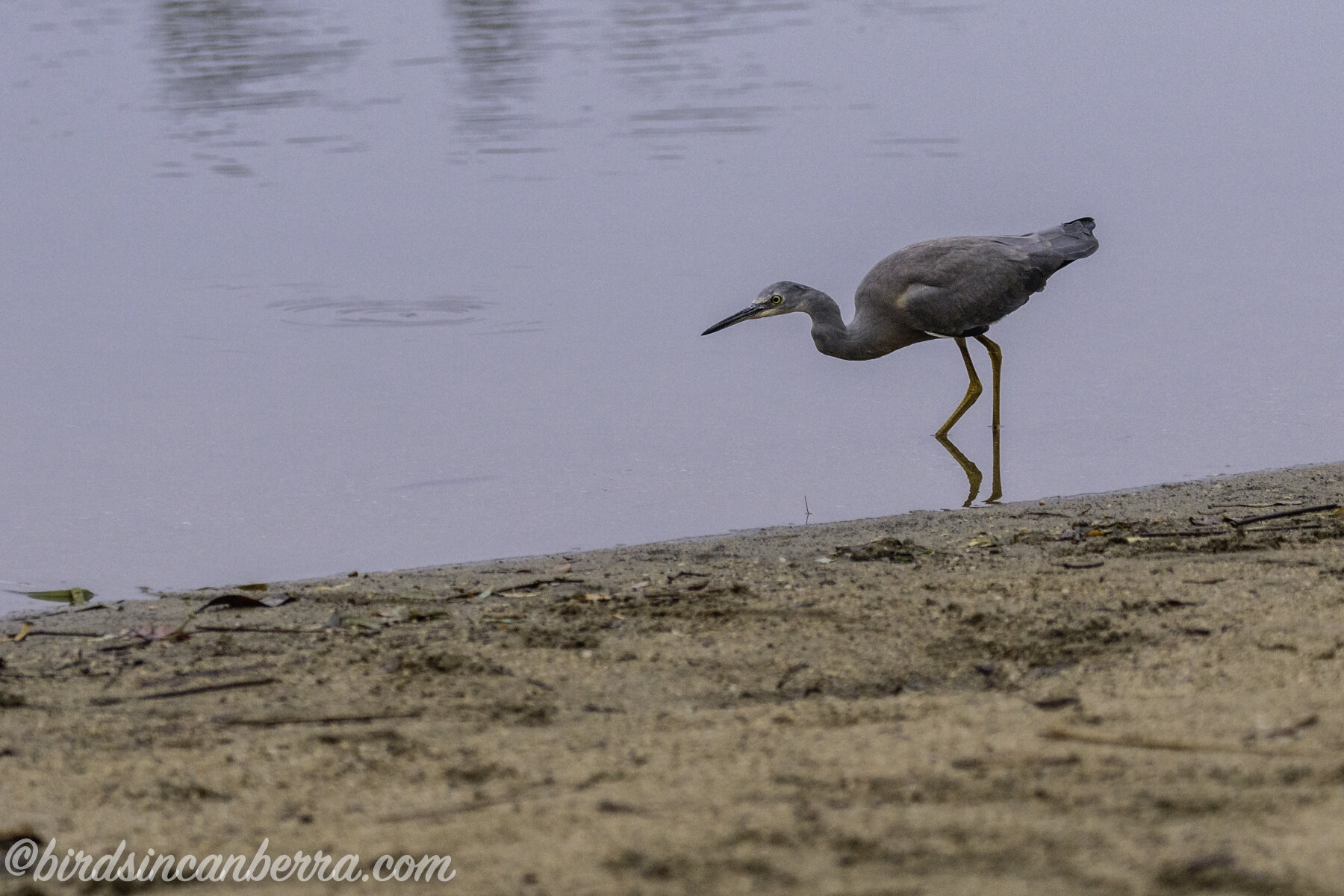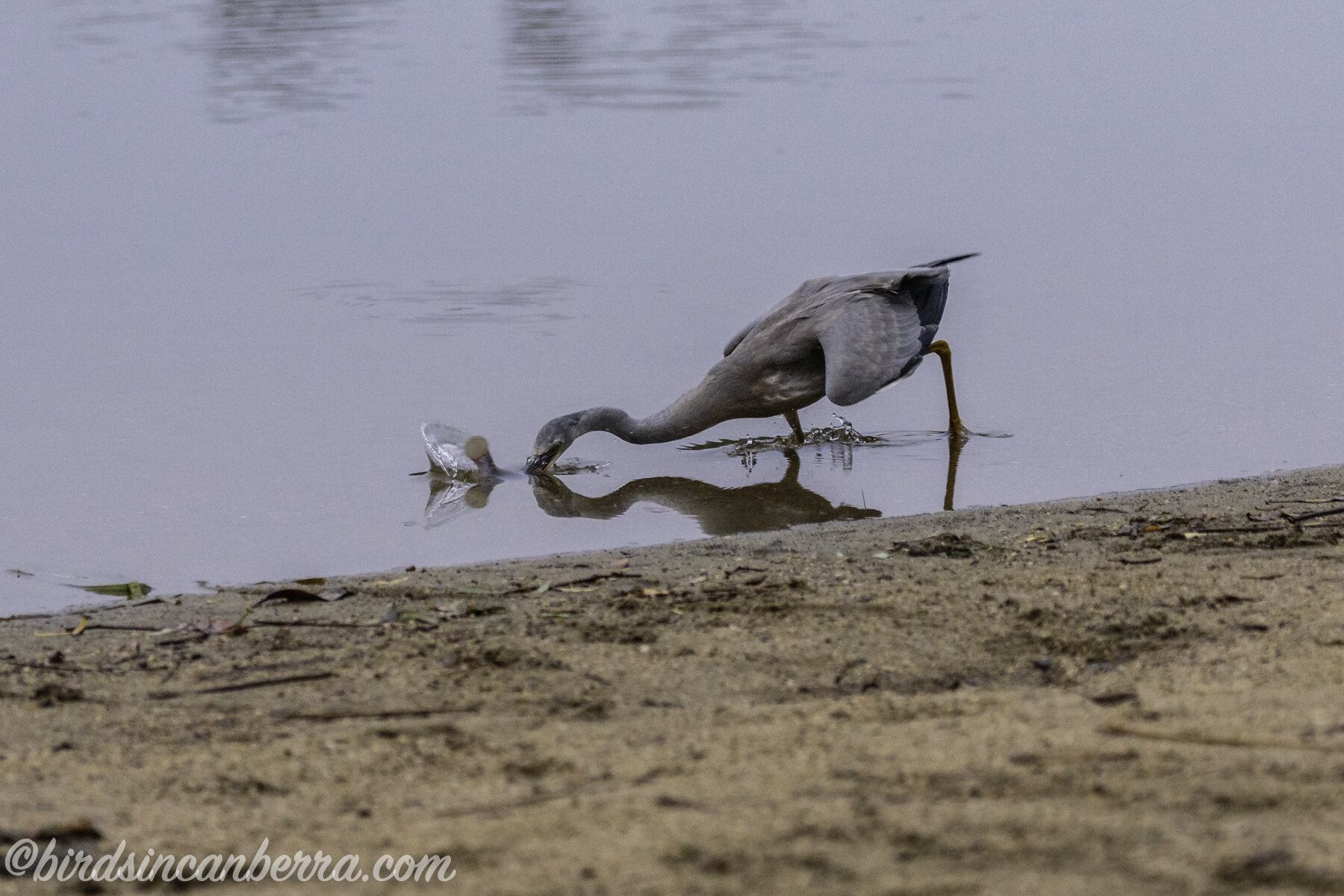Jerrabomberra Wetlands is such a gem for bird lovers in Canberra because there are always interesting birds to see yet it is basically right in the heart of Canberra. I had not been to the wetlands for a while but this time I wanted to try to see birds from a different angle, by photographing them from the water. I am enjoying paddling my kayak so I thought I would try photographing purely from the kayak, not going ashore at all. I was worried the whole time I was on the water that I would turn over and wreck my photography equipment but I think the morning turned out much better than I had hoped. A lot of birds seemed less worried about me, possibly as I was less ‘human’ sitting down in the kayak, letting it slowly drift towards the birds rather than walking to them on land. I had a marvellous morning right from the start when a White-faced Heron grabbed a fish out of the shallow water I was preparing to launch my kayak from. I saw so many wonderful birds I was late getting back to my start point. I also tried more videography from the kayak, which was very hard keeping the camera still, but the video is embedded below. In summary, I had a really enjoyable morning with the amazing birds and I hope you enjoy the photos below. (Please note, I did not realise 2 February was World Wetlands Day but what a good coincidence to publish this post on that appropriate day. I hope we can protect this wetland along with the others, they are truly fantastic places that are of great importance to us all.)
Cattle being used to help with fire risk reduction
(Canon EOS 7D Mk II with a Canon EF100-400mm f4.5-5.6L IS II USM [ISO 2000, 100mm, f/8.0 and 1/1000 SEC])
White-faced Herons (Egretta novaehollandiae) are very common birds around the wetlands, so I was not surprised, although I was very happy, when I saw one of these shallow water hunting specialists land near where I was about to launch my kayak at Molonglo Reach. It may have been a juvenile bird given the lack of white on the face. The heron flew from across the other side of the river and landed carefully in the shallow water almost in front of me, where upon it started moving slowly parallel to the shore. After a step or two, its head started to lower, while its pace slowed. Suddenly, its head shot forward into the water, which splashed up with the contortions of a fish fighting to escape. (The three photographs immediately below capture this action with the fish just visible as a dark, short line in the water to the left of the heron.) The heron steadily turned to shore, walking up onto the sand. It appeared to try to turn the fish around in its beak before it dropped the fish on the sand. The heron then pecked at the fish before picking it up and dropping it again. The bird did this a few times before the pecking got stronger. Eventually, it picked the fish up and flew off a little further down the river from me but on the same side.
The heron picking at the fish
(Canon EOS 7D Mk II with a Canon EF100-400mm f4.5-5.6L IS II USM [ISO 2000, 400mm, f/5.6 and 1/500 SEC])
This White-faced Heron was in a tree, and is most likely a juvenile given its ‘white face’ only exists below the beak. I did not see any birds feeding it, nor was there an obvious nest around but this heron did not seem ready to want to fly from the branch it was on. Herons normally only raise one chick so this may have been the only juvenile for a breeding pair. I did not get too close just in case I caused it any stress.
Juvenile White-faced Heron denoted by the lack of white in front of the eye above the beak
(Canon EOS 7D Mk II with a Canon EF100-400mm f4.5-5.6L IS II USM [ISO 3200, 400mm, f/5.6 and 1/500 SEC])
This adult White-faced Heron was further on than the other two. It was also hunting for food. Its very distinct white face showed clearly it was an adult.
White-faced Heron
(Canon EOS 7D Mk II with a Canon EF100-400mm f4.5-5.6L IS II USM [ISO 3200, 400mm, f/5.6 and 1/640 SEC])
Australasian Darters (Anhinga novaehollandiae) fascinate me with their snake-like necks that are the only things visible when they are swimming. Unfortunately, they tend to be hard to approach from the land so I was really happy to get close to these ones. The first one was in a tree and like the juvenile heron, did not appear ready to depart. It just stayed in the tree looking from side to side.
Australasian Darter in a tree above the Molonglo River
(Canon EOS 7D Mk II with a Canon EF100-400mm f4.5-5.6L IS II USM [ISO 2000, 400mm, f/5.6 and 1/500 SEC])
This darter was on a half-sunken log further out from shore. It stayed on the log as I paddled past on my outward journey and was still there on my return journey. I was not sure if it was drying its wings or contemplating escaping me. It moved along the log a bit and also looked from side to side as I got closer. It did not take off until I was on my return journey.
Australasian Darter drying its wings, a pity about the background
(Canon EOS 7D Mk II with a Canon EF100-400mm f4.5-5.6L IS II USM [ISO 2000, 278mm, f/8.0 and 1/800 SEC])
I was not trying to capture the bird defecating but this is a natural action
(Canon EOS 7D Mk II with a Canon EF100-400mm f4.5-5.6L IS II USM [ISO 2000, 278mm, f/8.0 and 1/800 SEC])
It was still in the same spot on the way back so I took some more photographs
(Canon EOS 7D Mk II with a Canon EF100-400mm f4.5-5.6L IS II USM [ISO 2000, 263mm, f/8.0 and 1/800 SEC])
This Pacific Black Duck (Anas superciliosa) was by itself on a little bit of wood. I was attracted by the lovely colour on its wing, as well as the colours of the wood, all reflecting in the water.
I just liked this composition with this Pacific Black Duck
(Canon EOS 7D Mk II with a Canon EF100-400mm f4.5-5.6L IS II USM [ISO 3200, 400mm, f/5.6 and 1/500 SEC])
A Willie Wagtail (Rhipidura leucophrys) was flitting over the shore probably looking for food. It also did not seem that concerned about my presence in the kayak.
Willie Wagtail
(Canon EOS 7D Mk II with a Canon EF100-400mm f4.5-5.6L IS II USM [ISO 3200, 400mm, f/5.6 and 1/640 SEC])
One bird that did not want me close was this Intermediate Egret (Ardea intermedia). Even though I was still a distance from the bird as it moved through the shallows it kept moving away from me. Eventually, it took off and flew further along the shoreline. I paddled further out into the lake so as not to disturb it again because it landed in the shallows in the direction I was heading. It was a beautiful bird and I was very happy with the way the shot came out but the bird was a little soft as the autofocus had a hard time detecting the white.
Intermediate Egret on the edge of the wetlands
(Canon EOS 7D Mk II with a Canon EF100-400mm f4.5-5.6L IS II USM [ISO 3200, 100mm, f/5.6 and 1/640 SEC])
This Black Swan (Cygnus atratus) family was possibly spooked by the flight of the egret as they started to move into the water as well. They did not swim along the shore but headed out into the lake, cutting across my direction of travel. I stopped paddling as I did not want to spook them. The four cygnets were still in their mottled colours while another Black Swan family that I saw later on had cygnets that had almost developed the black plumage.
Black Swans and cygnets
(Canon EOS 7D Mk II with a Canon EF100-400mm f4.5-5.6L IS II USM [ISO 3200, 100mm, f/5.6 and 1/640 SEC])
There were two Great Cormorants (Phalacrocorax carbo) perched on a half-submerged log. This is Australia’s largest cormorant and it lives in a number of countries beyond Australia, from north America through Europe to Asia. While I was watching them, one of the cormorants took off and almost hopping across the water before it was finally airborne. The other one stayed on the log, watching from both sides repeatedly.
One of the Great Cormorants
(Canon EOS 7D Mk II with a Canon EF100-400mm f4.5-5.6L IS II USM [ISO 2000, 255mm, f/8.0 and 1/800 SEC])
The other one
(Canon EOS 7D Mk II with a Canon EF100-400mm f4.5-5.6L IS II USM [ISO 2000, 255mm, f/8.0 and 1/800 SEC])
I will admit, this is my only picture of a Latham’s Snipe (Gallinago hardwickii) because I did not realise it was there. I was watching the Black-fronted Dotterels you can see in the foreground, as my kayak slowly travelled forward under its own momentum before it came to rest on the sand just in front of them. It was only later at home, in looking at this photograph on my computer, that I realised there was a Latham’s Snipe in the picture and if I had noticed at the time I could have zoomed in nicely on it. Better luck next time I hope.
Latham’s Snipe, I did not even realise it was there until I processed this picture of the Black-fronted Dotterels
(Canon EOS 7D Mk II with a Canon EF100-400mm f4.5-5.6L IS II USM [ISO 2000, 100mm, f/8.0 and 1/800 SEC])
Some Black-fronted Dotterels (Elseyornis melanops) kept me captivated as my kayak grounded just in front of them. They were looking for small animals in the mud, by pausing, running and striking. There was at least one juvenile in the group of possibly three birds. Although these birds are common, the destruction of their habitat is causing problems for them.
Black-fronted Dotterel
(Canon EOS 7D Mk II with a Canon EF100-400mm f4.5-5.6L IS II USM [ISO 2000, 400mm, f/8.0 and 1/800 SEC])
With some reflection
(Canon EOS 7D Mk II with a Canon EF100-400mm f4.5-5.6L IS II USM [ISO 2000, 400mm, f/8.0 and 1/800 SEC])
Two Black-winged Stilts (Himantopus himantopus) and a White-Faced Heron were looking for food near each other. The stilts were wading through the shallow water, quickly grabbing small animals they saw. From what I could see the different species did not seem to be competing with each other, which probably indicated there was sufficient food for all of them. Occasionally one of the stilts would tip almost half its body underwater to obtain food. These stilts are not just found in Australia but are common in a number of countries across the Americas, Africa, Asia and Oceania.
A pair of Black-winged Stilts looking for food near a White-faced Heron
(Canon EOS 7D Mk II with a Canon EF100-400mm f4.5-5.6L IS II USM [ISO 2000, 400mm, f/8.0 and 1/800 SEC])
A group of Welcome Swallows (Hirundo neoxena) were obtaining water from the Molonglo River as I paddled back to my exit. Swallows are really, fast and manoeuvrable birds and As you can see here they were really committed with getting water, often putting their whole body in for a quick swim. When they were not diving into the water they seemed to fly back into the wetlands. I always marvel at the way these birds can fly.
Welcome Swallows obtaining water
(Canon EOS 7D Mk II with a Canon EF100-400mm f4.5-5.6L IS II USM [ISO 2000, 400mm, f/8.0 and 1/1600 SEC])
They went a long way in
(Canon EOS 7D Mk II with a Canon EF100-400mm f4.5-5.6L IS II USM [ISO 2000, 400mm, f/8.0 and 1/2000 SEC])
This Australian White Ibis (Threskiornis molucca) was slowly stalking around a small pond which was almost cut-off. I just really liked the reflection in the water.
Australian White Ibis reflected as it wades through the shallows
(Canon EOS 7D Mk II with a Canon EF100-400mm f4.5-5.6L IS II USM [ISO 2000, 400mm, f/5.6 and 1/1000 SEC])
There was a group of Grey Teals (Anas gracilis), dabbling away in the same quiet pool, eating small animals and plants that they filtered through their bills.
Grey Teal dabbling in a side pond
(Canon EOS 7D Mk II with a Canon EF100-400mm f4.5-5.6L IS II USM [ISO 2000, 400mm, f/5.6 and 1/1000 SEC])
I could hear an Australian Reed Warbler (Acrocephalus australis) in the shrub beside my kayak while I sat at the end of the quiet pond mentioned above. Finally, the bird came forward on a branch looking for food and I was able to swing my lens around to photograph it without the bird flying off. Indeed, it stayed on the branch for a little while. I was very happy as these birds normally stay in reeds and plants, flying further in as people approach.
Australian Reed Warbler looking for food, in a shrub right beside my kayak
(Canon EOS 7D Mk II with a Canon EF100-400mm f4.5-5.6L IS II USM [ISO 2000, 400mm, f/5.6 and 1/1000 SEC])
A White-browed Scrubwren (Sericornis frontalis) was taking advantage of the low water level in the Molonglo River to search for food under a bank overhang. It was moving among the roots of the plants in the bank above. My kayak allowed me to get reasonably close but the overhang was very dark and the scrubwren was constantly moving.
White-browed Scrubwren under an eroded bank
(Canon EOS 7D Mk II with a Canon EF100-400mm f4.5-5.6L IS II USM [ISO 2000, 400mm, f/8.0 and 1/1000 SEC])
A group of Eurasian Coots (Fulica atra) were swimming on the Molonglo River, with one of the birds half-heartedly chasing another one. Neither bird flew off or went too far with the chase.
Eurasian Coot
(Canon EOS 7D Mk II with a Canon EF100-400mm f4.5-5.6L IS II USM [ISO 2000, 400mm, f/8.0 and 1/1000 SEC])
This Banded Antlion Lacewing (Glenoleon pulchellus) was on a wooden paling fence in my backyard and that was all it did. It was in shadow initially but as the sun rose its position came into the light. Despite me setting my camera and tripod up very close and using a flash, the only reaction l I could was its antenna moving. It was gone by the afternoon.
Antlion Lacewing on a wooden fence
(Canon EOS 6D Mk II with a Canon EF100mm f/2.8L Macro IS USM [ISO 160, 100mm, f/9.0 and 1/200 SEC])
A close-up of its head
(Canon EOS 6D Mk II with a Canon EF100mm f/2.8L Macro IS USM [ISO 160, 100mm, f/9.0 and 1/180 SEC])


